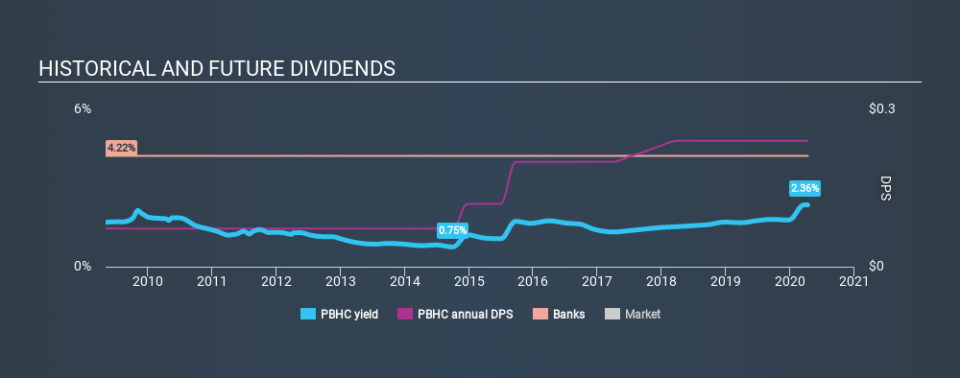Should You Buy Pathfinder Bancorp, Inc. (NASDAQ:PBHC) For Its Upcoming Dividend In 4 Days?

Pathfinder Bancorp, Inc. (NASDAQ:PBHC) stock is about to trade ex-dividend in 4 days time. You will need to purchase shares before the 15th of April to receive the dividend, which will be paid on the 8th of May.
Pathfinder Bancorp's next dividend payment will be US$0.06 per share, on the back of last year when the company paid a total of US$0.24 to shareholders. Calculating the last year's worth of payments shows that Pathfinder Bancorp has a trailing yield of 2.4% on the current share price of $10.19. We love seeing companies pay a dividend, but it's also important to be sure that laying the golden eggs isn't going to kill our golden goose! As a result, readers should always check whether Pathfinder Bancorp has been able to grow its dividends, or if the dividend might be cut.
Check out our latest analysis for Pathfinder Bancorp
Dividends are usually paid out of company profits, so if a company pays out more than it earned then its dividend is usually at greater risk of being cut. That's why it's good to see Pathfinder Bancorp paying out a modest 30% of its earnings.
When a company paid out less in dividends than it earned in profit, this generally suggests its dividend is affordable. The lower the % of its profit that it pays out, the greater the margin of safety for the dividend if the business enters a downturn.
Click here to see how much of its profit Pathfinder Bancorp paid out over the last 12 months.
Have Earnings And Dividends Been Growing?
Businesses with strong growth prospects usually make the best dividend payers, because it's easier to grow dividends when earnings per share are improving. If earnings fall far enough, the company could be forced to cut its dividend. With that in mind, we're encouraged by the steady growth at Pathfinder Bancorp, with earnings per share up 4.7% on average over the last five years.
Pathfinder Bancorp also issued more than 5% of its market cap in new stock during the past year, which we feel is likely to hurt its dividend prospects in the long run. Trying to grow the dividend while issuing large amounts of new shares reminds us of the ancient Greek tale of Sisyphus - perpetually pushing a boulder uphill.
The main way most investors will assess a company's dividend prospects is by checking the historical rate of dividend growth. Pathfinder Bancorp has delivered 13% dividend growth per year on average over the past ten years. It's encouraging to see the company lifting dividends while earnings are growing, suggesting at least some corporate interest in rewarding shareholders.
Final Takeaway
From a dividend perspective, should investors buy or avoid Pathfinder Bancorp? It has been growing its earnings per share somewhat in recent years, although it reinvests more than half its earnings in the business, which could suggest there are some growth projects that have not yet reached fruition. We think this is a pretty attractive combination, and would be interested in investigating Pathfinder Bancorp more closely.
With that in mind, a critical part of thorough stock research is being aware of any risks that stock currently faces. For example, we've found 2 warning signs for Pathfinder Bancorp that we recommend you consider before investing in the business.
If you're in the market for dividend stocks, we recommend checking our list of top dividend stocks with a greater than 2% yield and an upcoming dividend.
If you spot an error that warrants correction, please contact the editor at editorial-team@simplywallst.com. This article by Simply Wall St is general in nature. It does not constitute a recommendation to buy or sell any stock, and does not take account of your objectives, or your financial situation. Simply Wall St has no position in the stocks mentioned.
We aim to bring you long-term focused research analysis driven by fundamental data. Note that our analysis may not factor in the latest price-sensitive company announcements or qualitative material. Thank you for reading.

 Yahoo News
Yahoo News 

